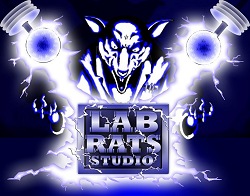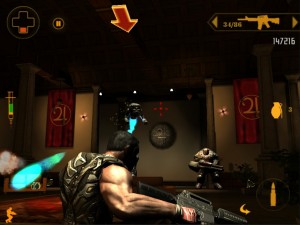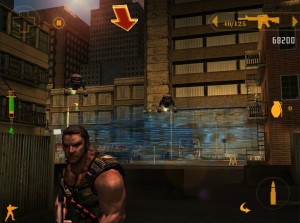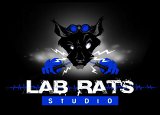 How many members work behind the Lab Rats Studio logo currently, and what are your game development backgrounds so far? Has the team been able to work on M.U.S.E. full-time, or have you been juggling game development with other work?
How many members work behind the Lab Rats Studio logo currently, and what are your game development backgrounds so far? Has the team been able to work on M.U.S.E. full-time, or have you been juggling game development with other work?
Lab Rats Studio started as a team of four founders: Alan Rueda, Shadie El-Haddad, Rion Holland, and Adrian Schmettau, whose mission is to create cutting edge videogames with our first focus on mobile gaming. We all met at Wake Tech Community College: three of us were in the simulation and game development program, while the latter was taking programming classes. We got accepted into the inaugural session of a local game development business accelerator called Joystick Labs and immediately began to work on our flagship commercial title, M.U.S.E. We slowly grew from four developers to a team of around ten and have been working on M.U.S.E. for just over a year now. We have been working full-time schedules on M.U.S.E., while some of us also have to work second jobs over the weekend to help pay bills.
 I must admit, I’ve been guilty of exclusively thinking “West Coast” when it comes to the best location for a videogame developer to operate in the U.S. However, I’ve discovered that there’s lots going on in North Carolina as well! What are some of the resources and opportunities Lab Rats has been able to seize by virtue of being located in the Tar Heel State?
I must admit, I’ve been guilty of exclusively thinking “West Coast” when it comes to the best location for a videogame developer to operate in the U.S. However, I’ve discovered that there’s lots going on in North Carolina as well! What are some of the resources and opportunities Lab Rats has been able to seize by virtue of being located in the Tar Heel State?
North Carolina is a great place to live and work, and is also a lot cheaper to run a business in than California. The Triangle (Raleigh-Durham-Chapel Hill) is actually the #1 game engine producer in the world, with the Unreal Engine, Vicious Engine, and Gamebryo Engine produced here. North Carolina is also home to some massive game development companies like Epic Games, Red Storm Entertainment, Insomniac Games, and EA Games. Raleigh, NC, also happens to be the ongoing location of the East Coast Game Conference, a newly created conference that celebrates games and their developers from all up and down the east coast. As mentioned, Lab Rats Studio benefited from Joystick Labs’ inaugural business accelerator session, as well as the beautiful office space at the American Tobacco Campus in historic downtown Durham, NC. We have also been embraced by some of the professional gaming establishments in the area, such as Red Storm, and have been given valuable insights and advice to help guide us along the way.
Tell us a little more about Joystick Labs, and the role that company played in helping kickstart Lab Rats Studio.
Joystick Labs helps entrepreneurs get seed funding to start their own game development company and begin development on a game for a share of the game’s profit. They helped us incorporate our company, get our legal work handled, and gave us business mentorship and advice along the way through their twelve week program. They also graciously allowed us to stick around their office space after our session had ended to finish the development of M.U.S.E. They are located in the beautiful American Tobacco Campus in the American Underground, an underground office complex that is home to a handful of the area’s brightest and most innovative technology start-ups.
 Moving on to M.U.S.E., I noticed that your upcoming release bears the subtitle “Issue 1: Cerebral Meltdown.” How many episodes do you have planned out so far, or are you waiting to see how the first does before moving on story-wise? Does Lab Rats have any plans to release the comic book story in some kind of anthology separate from the game(s), or is it imperative that the comic scenes and game stand together as an integrated whole?
Moving on to M.U.S.E., I noticed that your upcoming release bears the subtitle “Issue 1: Cerebral Meltdown.” How many episodes do you have planned out so far, or are you waiting to see how the first does before moving on story-wise? Does Lab Rats have any plans to release the comic book story in some kind of anthology separate from the game(s), or is it imperative that the comic scenes and game stand together as an integrated whole?
As of right now, M.U.S.E. is slated to span across three episodes. We plan to release the first episode in December and build upon its success with updates and subsequent episodes. The following episodes will take the player deeper into the rabbit hole and begin to introduce even more exciting features. As for the “comics,” what we have is comic-inspired animated 2D cutscenes that will help push the story forward. Those of you expecting traditional comic books moving from frame to frame with “Wham! Crash! Bang!” text boxes will want to look elsewhere for that.
How long has M.U.S.E. been in the works now? Was there anything about this game’s development cycle that’s proven so challenging to implement, or so time consuming, that it took the team by surprise?
M.U.S.E. has been in the works for just over a year now. We were all students or recent graduates when we started making M.U.S.E., so the biggest challenge has been learning as we go and figuring out what it takes to make a game polished and commercially appealing. We have spent a lot of time doing layers of polish on the game’s art style, control scheme, UI, animations — you name it, we have gone through a few iterations on it in order to make it better.
Another challenge that we experienced during the development of M.U.S.E. has been optimizing what we believe is a fairly graphically intense game for mobile devices. We have had to experiment with polygon count, particle effects, lighting, post-processing effects, full screen transparencies, etc., to find a good balance of performance and visuals that is appealing to players on 4th generation iDevices and up.
 How has the release of iOS 5 impacted the project?
How has the release of iOS 5 impacted the project?
The release of iOS 5 has had minimal impact on our development schedule, actually. We got iCloud saving, Airplay mirroring, and Twitter integration working in M.U.S.E. only a couple of days after iOS 5’s release, and plan to support these features in M.U.S.E. on day one. We plan to allow players to tweet their high scores using Twitter integration, allowing players to engage in some competition with their friends.


